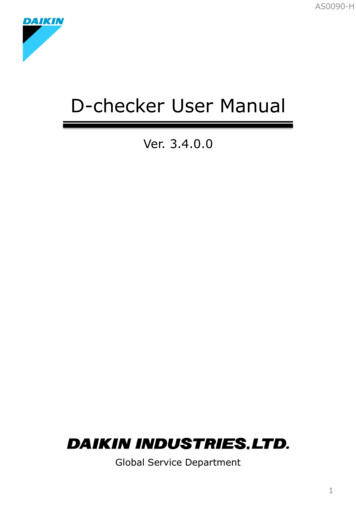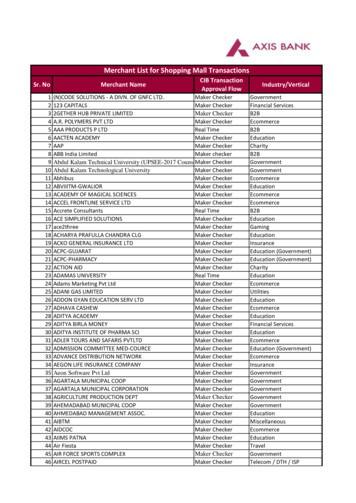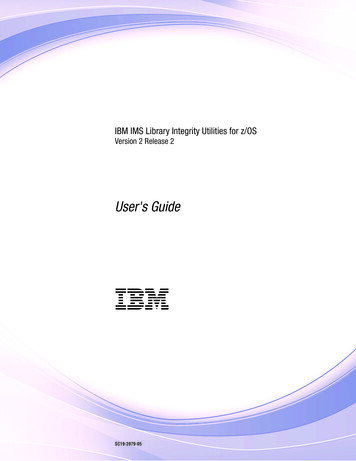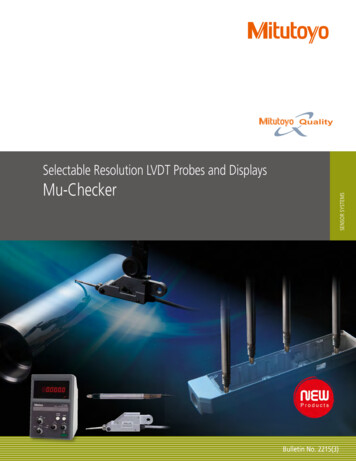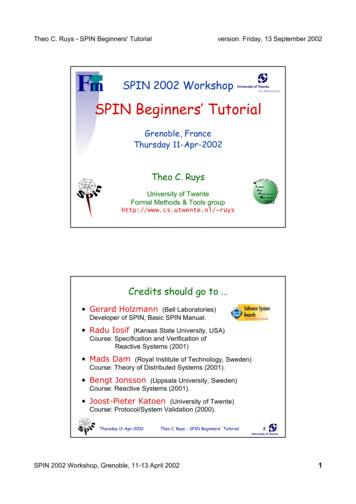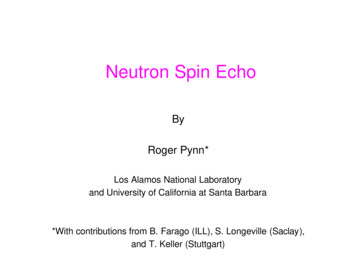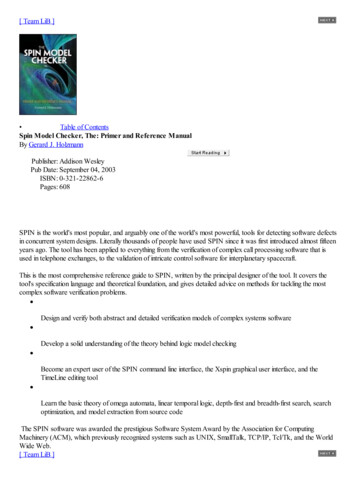
Transcription
[ Team LiB ] Table of ContentsSpin Model Checker, The: Primer and Reference ManualBy Gerard J. HolzmannPublisher: Addison WesleyPub Date: September 04, 2003ISBN: 0-321-22862-6Pages: 608SPIN is the world's most popular, and arguably one of the world's most powerful, tools for detecting software defectsin concurrent system designs. Literally thousands of people have used SPIN since it was first introduced almost fifteenyears ago. The tool has been applied to everything from the verification of complex call processing software that isused in telephone exchanges, to the validation of intricate control software for interplanetary spacecraft.This is the most comprehensive reference guide to SPIN, written by the principal designer of the tool. It covers thetool's specification language and theoretical foundation, and gives detailed advice on methods for tackling the mostcomplex software verification problems. Design and verify both abstract and detailed verification models of complex systems software Develop a solid understanding of the theory behind logic model checking Become an expert user of the SPIN command line interface, the Xspin graphical user interface, and theTimeLine editing tool Learn the basic theory of omega automata, linear temporal logic, depth-first and breadth-first search, searchoptimization, and model extraction from source codeThe SPIN software was awarded the prestigious Software System Award by the Association for ComputingMachinery (ACM), which previously recognized systems such as UNIX, SmallTalk, TCP/IP, Tcl/Tk, and the WorldWide Web.[ Team LiB ]
[ Team LiB ] Table of ContentsSpin Model Checker, The: Primer and Reference ManualBy Gerard J. HolzmannPublisher: Addison WesleyPub Date: September 04, 2003ISBN: 0-321-22862-6Pages: 608CopyrightPrefaceLogic Model CheckingThe SPIN Model CheckerBook StructureChapter 1. Finding Bugs in Concurrent SystemsCircular BlockingDeadly EmbraceMismatched AssumptionsFundamental Problems of ConcurrencyChapter 2. Building Verification ModelsSPINPROMELAExamplesHello WorldProducers and ConsumersExtending the ExampleMutual ExclusionMessage PassingIn SummaryBibliographic NotesChapter 3. An Overview of PROMELATypes of ObjectsProcessesProvided ClausesData ObjectsData StructuresMessage Channels
Channel Poll OperationsSorted Send And Random ReceiveRendezvous CommunicationRules For ExecutabilityAssignments And ExpressionsControl Flow: Compound StatementsAtomic SequencesDeterministic StepsSelectionRepetitionEscape SequencesInline DefinitionsReading InputSpecial FeaturesFinding Out MoreChapter 4. Defining Correctness ClaimsStronger ProofBasic Types of ClaimsBasic AssertionsMeta LabelsFair CyclesNever ClaimsThe Link With LTLTrace AssertionsNotracePredefined Variables and FunctionsRemote ReferencingPath QuantificationFormalitiesFinding Out MoreChapter 5. Using Design AbstractionWhat Makes a Good Design Abstraction?Data and ControlThe Smallest Sufficient ModelAvoiding RedundancyCountersSinks, Sources, and FiltersSimple Refutation ModelsPathfinderA Disk-Head SchedulerControlling ComplexityExampleA Formal Basis for ReductionExample – A File ServerIn SummaryBibliographic NotesChapter 6. Automata and LogicAutomataOmega AcceptanceThe Stutter Extension RuleFinite States, Infinite RunsOther Types of Acceptance
LogicTemporal LogicRecurrence and StabilityUsing Temporal LogicValuation SequencesStutter InvarianceFairnessFrom Logic To AutomataAn ExampleOmega-Regular PropertiesOther LogicsBibliographic NotesChapter 7. PROMELA SemanticsTransition RelationOperational ModelOperational Model, Semantics EngineInterpreting PROMELA ModelsThree ExamplesVerificationThe Never ClaimChapter 8. Search AlgorithmsDepth-First SearchChecking Safety PropertiesDepth-Limited SearchTrade-OffsBreadth-First SearchChecking Liveness PropertiesAdding FairnessThe SPIN ImplementationComplexity RevisitedBibliographic NotesChapter 9. Search OptimizationPartial Order ReductionVisibilityStatement MergingState CompressionCollapse CompressionMinimized Automaton RepresentationBitstate HashingBloom FiltersHash-CompactBibliographic NotesChapter 10. Notes on Model ExtractionThe Role of AbstractionFrom ANSI-C to PROMELAEmbedded AssertionsA Framework for AbstractionSound and Complete AbstractionSelective Data HidingExampleBolder Abstractions
Dealing With False NegativesThorny Issues With Embedded C CodeThe Model Extraction ProcessThe Halting Problem RevisitedBibliographic NotesChapter 11. Using SPINSPIN StructureRoadmapSimulationRandom SimulationInteractive SimulationGuided SimulationVerificationGenerating a VerifierCompiling the VerifierTuning a Verification RunThe Number of Reachable StatesSearch DepthCycle DetectionInspecting Error TracesInternal State NumbersSpecial CasesDisabling Partial Order ReductionBoosting PerformanceSeparate CompilationLowering Verification ComplexityChapter 12. Notes on XSPINStarting a Session With XSPINThe File MenuThe Edit MenuThe Help MenuThe Run MenuSyntax CheckProperty-Based SlicingSet Simulation Parameters(Re)Run SimulationSet Verification Parameters(Re)Run VerificationLTL Property ManagerThe Automaton View OptionIn SummaryChapter 13. The Timeline EditorAn ExampleTypes of EventsDefining EventsMatching a TimelineAutomata DefinitionsConstraintsVariations on a ThemeTimelines With One EventTimelines With Multiple EventsThe Link With LTL
Bibliographic NotesChapter 14. A Verification Model of a Telephone SwitchGeneral ApproachKeep it SimpleManaging ComplexityModeling a SwitchSubscriber ModelSwitch ModelRemote SwitchesAdding FeaturesThree-Way CallingA Three-Way Calling ScenarioIn SummaryChapter 15. Sample SPIN ModelsEratosthenesProcess SchedulingA Client-Server ModelSquare Roots?Adding InteractionAdding AssertionsA Comment FilterChapter 16. PROMELA Language xamplesNotesSee AlsoGrammar RulesMain SectionsReferenceSpecial Caseslastnr chancommentscond exprconditiond stepdatatypesdo
tynevernfullnppc NtimeouttracetruetypedefunlessxrChapter 17. Embedded C CodeAn Example
Data ReferencesExecutionIssues to ConsiderDeferring File Inclusionc codec declc exprChapter 18. Overview of SPIN OptionsCompile-Time OptionsSimulation OptionsSyntax Checking OptionsPostscript GenerationModel Checker GenerationLTL ConversionMiscellaneous OptionsChapter 19. Overview of PAN OptionsPAN Compile-Time OptionsBasic OptionsOptions Related to Partial Order ReductionOptions Used to Increase SpeedOptions Used to Decrease Memory UseOptions to Use When Prompted by PANOptions for Debugging PAN VerifiersExperimental OptionsPAN Run-Time OptionsPAN Output FormatLiteratureAppendix A. Automata ProductsAsynchronous ProductsEncoding Atomic SequencesRendezvousSynchronous ProductsAn ExampleNon-Progress CyclesDeadlock DetectionAppendix B. The Great DebatesBranching Time vs Linear TimeSymbolic Verification vs Explicit VerificationBreadth-First Search vs Depth-First SearchTarjan Search vs Nested SearchEvents vs StatesRealtime Verification vs Timeless VerificationProbability vs PossibiltyAsynchronous Systems vs Synchronous SystemsInterleaving vs True ConcurrencyOpen vs Closed SystemsAppendix C. Exercises With SPINC.1.C.2.C.3.
C.4.C.5.C.6.C.7.C.8.C.9.Appendix D. Downloading SpinLTL ConversionModel ExtractionTimeline EditorTables and FiguresTablesFigures[ Team LiB ]
[ Team LiB ]
CopyrightMany of the designations used by manufacturers and sellers to distinguish their products are claimed as trademarks.Where those designations appear in this book, and Addison-Wesley, Inc. was aware of a trademark claim, thedesignations have been printed with initial capital letters or in all capitals.The author and publisher have taken care in the preparation of this book, but make no expressed or implied warrantyof any kind and assume no responsibility for errors or omissions. No liability is assumed for incidental or consequentialdamages in connection with or arising out of the use of the information or programs contained herein.The publisher offers discounts on this book when ordered in quantity for special sales. For more information, pleasecontact:U.S. Corporate and Government Sales: (800) 382-3419corpsales@pearsontechgroup.comFor sales outside the U.S., please contact:International Sales: (317) 581-3793international@pearsontechgroup.comVisit Addison-Wesley on the Web at: awprofessional.comLibrary of Congress Cataloging-in-Publication DataHolzmann, Gerard J.The Spin model checker: primer and reference manual / Gerard J. Holzmannp. cmIncludes bibliographical references and index.ISBN 0-321-22862-61. Systems engineering––Mathematical models. 2. Computer programs––Testing. I. Title.TA168.H65 2003620'.001'171––dc222003057704CIPCopyright 2004 Lucent Technologies Inc., Bell Laboratories.All rights reserved. No part of this publication may be reproduced, stored in a retrieval system, or transmitted, in anyform or by any means, electronic, mechanical, photocopying, recording, or otherwise, without the prior consent of thepublisher. Printed in the United States of America. Published simultaneously in Canada.This book was written, designed, and typeset by the author while affiliated with the Computing Sciences ResearchCenter at Bell Laboratories. His current affiliation is with the Laboratory for Reliable Software at NASA's JetPropulsion Laboratory / California Institute of Technology.For information on obtaining permission to use material from this work, submit a request to:Pearson Education, Inc.Rights and Contracts Department
[ Team LiB ]
[ Team LiB ]Preface"If you don't know where you're going, it doesn't really matter which path you take."—(Lewis Carroll, 1832–1898)"You got to be careful if you don't know where you're going, because you might not get there."—(Yogi Berra, 1925–)"The worst thing about new books is that they keep us from reading the old ones.''—(Joseph Joubert, 1754–1824)A system is correct if it meets its design requirements. This much is agreed. But if the system we are designing is apiece of software, especially if it involves concurrency, how can we show this? It is not enough to merely show that asystem can meet its requirements. A few tests generally suffice to demonstrate that. The real test is to show that asystem cannot fail to meet its requirements.Dijkstra's well-known dictum on testing[1] applies especially to concurrent software: the non-determinism ofconcurrent system executions makes it hard to devise a traditional test suite with sufficient coverage. There arefundamental problems here, related to both the limited controllability of events in distributed system executions and tothe limited observability of those events.[2][1] The quote "Program testing can be used to show the presence of bugs, but never to show their absence" firstappeared in Dijkstra [1972], p. 6. The quote has a curious pendant in Dijkstra [1965] that is rarely mentioned: "Onecan never guarantee that a proof is correct, the best one can say is: "I have not discovered any mistakes.""[2] For instance, process scheduling decisions made simultaneously by different processors at distinct locations in alarger network.A well-designed system provably meets its design requirements. But, if we cannot achieve this degree of certainty withstandard test methods, what else can we do? Using standard mathematics is not much of an option in this domain. Athorough hand proof of even simple distributed programs can challenge the most hardened mathematician. At firstblush, mechanical proof procedures also do not seem to hold much promise: it was shown long ago that it isfundamentally impossible to construct a general proof procedure for arbitrary programs.[3] So what gives?[3] The unsolvability of the halting problem, for instance, was already proven in Turing [1936].Fortunately, if some modest conditions are met, we can mechanically verify the correctness of distributed systemssoftware. It is the subject of this book to show what these "modest conditions" are and how we can use relativelysimple tool-based verification techniques to tackle demanding software design problems.[ Team LiB ]
[ Team LiB ]Logic Model CheckingThe method that we will use to check the correctness of software designs is standard in most engineering disciplines.The method is called model checking. When the software itself cannot be verified exhaustively, we can build asimplified model of the underlying design that preserves its essential characteristics but that avoids known sources ofcomplexity. The design model can often be verified, while the full-scale implementation cannot.Bridge builders and airplane designers apply much the same technique when faced with complex design problems. Bybuilding and analyzing models (or prototypes) the risk of implementing a subtly flawed design is reduced. It is oftentoo expensive to locate or fix design errors once they have reached the implementation phase. The same is true for thedesign of complex software.The modeling techniques that we discuss in this book work especially well for concurrent software, which, as luckwill have it, is also the most difficult to debug and test with traditional means.The models we will build can be seen as little programs, written in, what may at first look like, a strangely abstractlanguage. The models that are written in this language are in fact executable. The behaviors they specify can besimulated and explored exhaustively by the model checker in the hunt for logic errors. Constructing and executingthese high-level models can be fun and insightful. It often also gives a sufficiently different perspective on aprogramming problem that may lead to new solutions, even before any precise checks are performed.A logic model checker is designed to use efficient procedures for characterizing all possible executions, rather than asmall subset, as one might see in trial executions. Since it can explore all behaviors, the model checker can apply arange of sanity checks to the design model, and it can successfully identify unexecutable code, or potentiallydeadlocking concurrent executions. It can even check for compliance with complex user-defined correctness criteria.Model checkers are unequalled in their ability to locate subtle bugs in system designs, providing far greater controlthan the more traditional methods based on human inspection, testing, or random simulation.Model checking techniques have been applied in large scale industrial applications, to reduce the reliance on testing,to detect design flaws early in a design cycle, or to prove their absence in a final design. Some examples of theseapplications are discussed in this book.[ Team LiB ]
[ Team LiB ]The SPIN Model CheckerThe methodology we describe in this book centers on the use of the model checker SPIN. This verification systemwas developed at Bell Labs in the eighties and nineties and is freely available from the Web (see Appendix D). Thetool continues to evolve and has over many years attracted a fairly broad group of users in both academia andindustry. At the time of writing, SPIN is one of the most widely used logic model checkers in the world.In 2002 SPIN was recognized by the ACM (the Association for Computing Machinery) with its most prestigiousSoftware System Award. In receiving this award, SPIN was placed in the league of truly breakthrough softwaresystems such as UNIX, TeX, Smalltalk, Postscript, TCP/IP, and Tcl/Tk. The award has brought a significant amountof additional attention to the tool and its underlying technology. With all these developments there has been a growingneed for a single authoritative and comprehensive user guide. This book is meant to be that guide.The material in this book can be used either as classroom material or as a self-study guide for new users who want tolearn about the background and use of logic model checking techniques. A significant part of the book is devoted to acomprehensive set of reference materials for SPIN that combines information that both novice and experienced userscan apply on a daily basis.[ Team LiB ]
[ Team LiB ]Book StructureSPIN can be used to thoroughly check high-level models of concurrent systems. This means that we first have toexplain how one can conveniently model the behavior of a concurrent system in such a way that SPIN can check it.Next, we have to show how to define correctness properties for the detailed checks, and how to design abstractionmethods that can be used to render seemingly complex verification problems tractable. We do all this in the first partof this book, Chapters 1 to 5.The second part, Chapters 6 to 10, provides a treatment of the theory behind software model checking, and adetailed explanation of the fundamental algorithms that are used in SPIN.The third part of the book, Chapters 11 to 15, contains more targeted help in getting started with the practicalapplication of the tool. In this part of the book we discuss the command line interface to SPIN, the graphical userinterface XSPIN, and also a closely related graphical tool that can be used for an intuitive specification of correctnessproperties, the Timeline editor. This part is concluded with a discussion of the application of SPIN to a range ofstandard problems in distributed systems design.Chapters 16 to 19, the fourth and last part of the book, include a complete set of reference materials for SPIN andits input language, information that was so far only available in scattered form in books, tutorials, papers, and Webpages. This part contains a full set of manual pages for every language construct and every tool option available in themost recent versions of SPIN and XSPIN.The Web site http://spinroot.com/spin/Doc/Book extras/ contains online versions of all examples used in this book,some lecture materials, and an up to date list of errata.For courses in model checking techniques, the material included here can provide both a thorough understanding ofthe theory of logic model checking and hands-on training with the practical application of a well-known modelchecking system. For a more targeted use that is focused directly on the practical application of SPIN, the morefoundational part of the book can be skipped.A first version of this text was used for several courses in formal verification techniques that I taught at PrincetonUniversity in New Jersey, at Columbia University in New York, and at the Royal Institute of Technology inStockholm, Sweden, in the early nineties. I am most grateful to everyone who gave feedback, caught errors, andmade suggestions for improvements, as well as to all dedicated SPIN users who have graciously done this throughoutthe years, and who fortunately continue to do so.I especially would like to thank Dragan Bosnacki, from Eindhoven University in The Netherlands, who read multipledrafts for this book with an unusually keen eye for spotting inconsistencies, and intercepting flaws. I would also like tothank Al Aho, Rajeev Alur, Jon Bentley, Ramesh Bharadwaj, Ed Brinksma, Marsha Chechik, Costas Courcoubetis,Dennis Dams, Matt Dwyer, Vic Du, Kousha Etessami, Michael Ferguson, Rob Gerth, Patrice Godefroid, Jan Hajek,John Hatcliff, Klaus Havelund, Leszek Holenderski, Brian Kernighan, Orna Kupferman, Bob Kurshan, PedroMerino, Alice Miller, Doug McIlroy, Anna Beate Oestreicher, Doron Peled, Rob Pike, Amir Pnueli, Anuj Puri,Norman Ramsey, Jim Reeds, Dennis Ritchie, Willem-Paul de Roever, Judi Romijn, Theo Ruys, Ravi Sethi, MargaretSmith, Heikki Tauriainen, Ken Thompson, Howard Trickey, Moshe Vardi, Phil Winterbottom, Pierre Wolper,Mihalis Yannakakis, and Ozan Yigit, for their often profound influence that helped to shape the tool, and this book.Gerard J. Holzmanngholzmann@acm.org[ Team LiB ]
[ Team LiB ]Chapter 1. Finding Bugs in Concurrent Systems"For we can get some idea of a whole from a part, but never knowledge or exact opinion."—(Polybius, ca. 150 B.C., Histories, Book I:4)SPIN can be used to verify correctness requirements for systems of concurrently executing processes. The toolworks by thoroughly checking either hand-built or mechanically generated models that capture the essential elementsof a distributed systems design. If a requirement is not satisfied, SPIN can produce a sample execution of the modelto demonstrate this.There are two basic ways of working with SPIN in systems design. The first method, and the primary focus of thisbook, is to use the tool to construct verification models that can be shown to have all the required system properties.Once the basic design of a system has been shown to be logically sound, it can be implemented with confidence. Asecond, less direct, method is to start from an implementation and to convert critical parts of that implementationmechanically into verification models that are then analyzed with SPIN. Automated model extraction tools have beenbuilt to convert programs written in mainstream programming languages such as Java and C into SPIN models. Adiscussion of the latter approach to software verification is given in Chapter 10, and the constructs in SPIN thatdirectly support model extraction techniques are discussed in Chapter 17.We begin by considering in a little more detail what makes it so hard to test concurrent software systems, and whythere is a need for tools such as SPIN.It is worth noting up front that the difficulty we encounter when trying to reason about concurrent systems is notrestricted to software design. Almost everything of interest that happens in our world involves concurrency and accessto shared resources. In the supermarket, customers compete for shared resources, both consumable ones (such asfood items) and non-consumable ones (such as checkout clerks). Customers follow simple, and very ancient,protocols for breaking ties and resolving conflicts. On the road, cars compete for access to road intersections andparking spots. In telephone systems, similarly, large numbers of simultaneous users compete for shared resources, thistime with the unique feature that the users themselves are among the resources being shared. Problems of interactionoccur in all these cases, and any new and untried set of rules that we may come up with to solve these problems canbackfire in unexpected, sometimes amusing, and sometimes disastrous, ways.[ Team LiB ]
[ Team LiB ]Circular BlockingAs a simple example, we can look at the protocol rules that regulate the movements of cars across intersections.There is no unique solution, or even a best solution to this problem, as testified by the widely different standards thathave been adopted in different countries around the world. In the U.S., when two roads intersect, one direction oftraffic always explicitly has priority over the other direction, as indicated by markings on the pavement and byroadsigns. At traffic circles, however, an implicit rule applies, rarely explicitly indicated, giving priority to traffic insidethe circle. The implicit rule for circles is sensible, since it gives priority to cars leaving the circle over cars trying toenter it, which can avoid congestion problems.In some European countries, the implicit and explicit rules are reversed. In the Netherlands, for instance, an implicitrule states that at otherwise unmarked intersections cars approaching from one's right have the right of way. The rulefor traffic circles is explicitly marked to override this rule, again giving priority to traffic inside the circle. The implicitrule for unmarked intersections is simple and effective. But this rule can have unexpected consequences under heavytraffic conditions, as illustrated in Figure 1.1. It is not even true that we could avoid this problem with traffic lights thatregularly reverse priority rules. One visit to a sufficiently large city will suffice to make it clear that this cannot preventthe problem. A fixed priority rule is not preferable either, since it will allow one direction of traffic to deny access tothe other direction for any length of time. On the road, the occurrence of these conditions is typically accepted as justanother fact of life. When they occur, they can often only be resolved by breaking the otherwise agreed upon rules. Itwill be clear that in software systems we cannot rely on such resolutions: The rules must cover all conceivable cases,and unfortunately, they must also cover all the humanly inconceivable ones.Figure 1.1. Circular Blocking[ Team LiB ]
[ Team LiB ]Deadly EmbraceAs another everyday example, to make a person-to-person call, a user must secure exclusive access to at least twoshared resources in the telephone system: the line of the calling party and the line of the called party. The resourcesare allocated in a fixed order. Access is always first granted to the calling party's line and only then to the calledparty's line. Normally this causes no hardship, but when two subscribers A and B simultaneously attempt to establisha connection to each other, the access rules will prevent this. If both parties repeatedly pick up the receiversimultaneously to dial the connection, and refuse to give up until access is granted, they will repeatedly fail. This isespecially curious because the two requests do not actually conflict: both subscribers desire the connection.A very similar problem is encountered in the management of shared resources in operating systems. Virtually everytextbook on operating systems contains a description of the problem. In the example used there, the shared resourcesare typically a line printer (A) and a card reader (B); the example is indeed that old. Two user processes thencompete for exclusive access to these resources, both of which may be needed simultaneously, for instance to print adeck of punchcards. A deadly embrace is entered when both processes succeed in obtaining access to one of the tworesources and then decide to wait indefinitely for the other. Of course it will not do to just require the processes toyield resources back to the operating system while waiting for more resources to become available.The generic sequence of steps leading into the deadly embrace is illustrated in Figure 1.2. The solid arrows indicatethe control-flow order in the two user processes. Once the two dashed states are reached simultaneously, there is noway to proceed. The dotted arrows indicate the dependency relations that prevent progress. Before device B can beobtained by the first process, it must first be released by the second process, and before device A can be obtained bythe second process, it must first be released by the first. The circular dependencies illustrate the deadly embrace.Figure 1.2. Deadly Embrace[ Team LiB ]
[ Team LiB ]Mismatched AssumptionsIt is a trusted premise of systems engineering that large systems should be built from smaller components, each ofwhich can be designed and tested with a high degree of confidence. Ideally, the final system is then only assembledwhen all the smaller pieces have been proven correct. Some design problems, though, only become evident at thesystem level, and the absence of reliable methods for testing system level problems can sometimes take us by surprise.Decisions that are perfectly legitimate at the component level can have unexpected, and sometimes dramaticconsequences at the system level.A good illustration of this phenomenon is what happened September 14, 1993 on the runway at Warsaw airport inPoland.[1] A Lufthansa Airbus A320-200 with 72 people on board was landing in heavy rain. The plane was notgetting much traction from the wheels in the landing gear on the wet runway, but the pilots knew that they could counton the thrust reversers on the main engines to bring the plane to a stop. As it happened, the thrust reversers failed todeploy in time, and the plane overshot the end of the runway.[1] A description of this accident can be found on the Web site www.crashdatabase.com.A thrust reverser should, of course, never be activated when a plane is in flight. Most planes, therefore, haveelaborate protection built-in to prevent this from happening. This includes, for instance, that the thrust reversers cannotbe deployed unless three conditions are met: the landing gear must be down, the wheels must be turning, and theweight of the plane must be carried on the wheels. In this case the landing gear was down, but the wheels werehydroplaning, and an unexpected tailwind provided enough lift on the wings that the control software did not decideuntil nine seconds after touchdown that the plane had landed. Two people lost their lives when the plane went off theend of the runway.The most fascinating aspect of an accident like this is that no one really made any mistakes in the design or operationof this plane. All components were designed in a very sensible manner. The control software for the thrust reversers,though, was not designed to cope with the unexpected combination of events that occurred. This software formed onecomponent in a complex system with many other interacting parts, including the dominant weather conditions that canaffect a plane's operation.When complex systems fail, the scenarios that trigger the failures usually could not easily have been imagined by anysensible human designer. For every one failure scenario that is considered, there are a million others that may beoverlooked. In cases like this, it is invaluable to have design tools that can hunt down the potential error scenariosautomatically, working from a sober description of the individual piece parts that together form a more complexintegrated system. Automated tools have no trouble constructing the bizarre scenarios that
SPIN is the world's most popular, and arguably one of the world's most powerful, tools for detecting software defects in concurrent system designs. Literally thousands of people have used SPIN since it was first introduced almost fifteen years ago. The tool has been applied to everything from the verification of complex call processing software .


